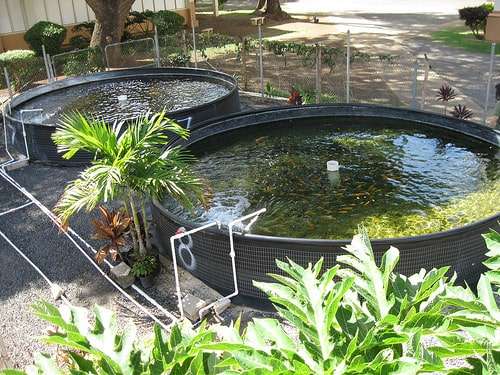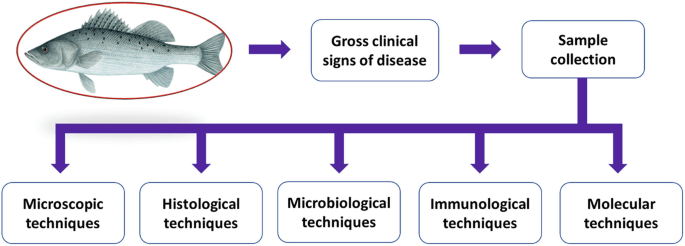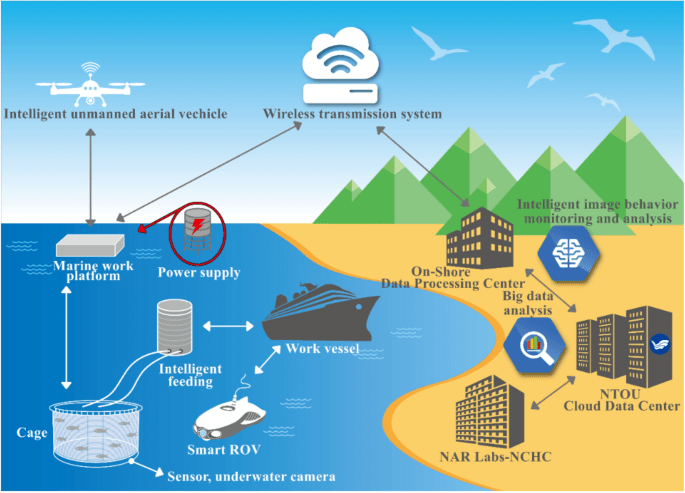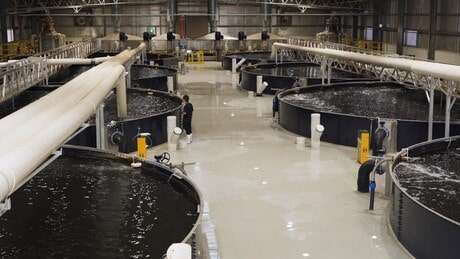The Barramundi Aquaculture Landscape
Barramundi, known for its mild flavor and tender texture, has become a sought-after delicacy in various culinary traditions. To meet the escalating demand while preserving natural ecosystems, aquaculture emerged as a solution. Source
Barramundi farming involves rearing these fish in controlled environments, often in tanks or ponds, replicating their natural habitat conditions. However, like any form of agriculture, barramundi farming comes with challenges such as disease outbreaks, water quality management, and feeding optimization.
Source
Barramundi farming involves rearing these fish in controlled environments, often in tanks or ponds, replicating their natural habitat conditions. However, like any form of agriculture, barramundi farming comes with challenges such as disease outbreaks, water quality management, and feeding optimization.
AI’s Role in Barramundi Farming: A Revolutionary Partnership
Artificial Intelligence offers an ingenious solution to many of the challenges faced by barramundi farmers. By integrating AI-powered systems, farms can not only enhance productivity but also mitigate environmental impacts. Here’s a closer look at how AI can revolutionize barramundi farming:1. Disease Detection and Prevention
 Source
AI systems can analyze barramundi behavior and health metrics to detect signs of distress or disease at an early stage. Cameras and sensors placed in the farming environment monitor fish behavior, identifying any abnormal patterns.
By doing so, farmers can promptly isolate infected fish, preventing the spread of diseases and minimizing losses.
Source
AI systems can analyze barramundi behavior and health metrics to detect signs of distress or disease at an early stage. Cameras and sensors placed in the farming environment monitor fish behavior, identifying any abnormal patterns.
By doing so, farmers can promptly isolate infected fish, preventing the spread of diseases and minimizing losses.
2. Water Quality Monitoring
Maintaining optimal water quality is crucial for barramundi health. AI-powered sensors continuously monitor parameters such as temperature, oxygen levels, and ph. These systems can predict potential water quality issues and provide real-time alerts to farmers, enabling them to take immediate corrective actions.3. Feeding Optimization
AI algorithms can process data from sensors and cameras to determine the precise amount of feed needed based on the fish’s growth rate, behavior, and environmental conditions. This reduces overfeeding, which not only saves resources but also prevents water pollution caused by excess feed.4. Environmental Impact Reduction
AI-equipped farms can operate more sustainably by optimizing resource usage. For instance, by fine-tuning feeding schedules and quantities, AI reduces the excessive use of feed, decreasing waste and its associated environmental impact. Additionally, AI-driven water quality management minimizes the risk of harmful pollutants entering natural water bodies. Source
Source
5. Predictive Analytics
AI analyzes historical data and current conditions to generate predictive models. This aids farmers in making informed decisions about stocking density, feed procurement, and harvest timing. Accurate predictions empower farmers to optimize their operations and improve overall efficiency.6. Remote Monitoring and Control
AI allows farmers to remotely monitor their operations through mobile apps or web platforms. This capability is particularly beneficial for large-scale farms or those located in remote areas. Farmers can receive alerts, access real-time data, and even control certain aspects of the farming environment from a distance.The Significance of AI in Barramundi Farming
Barramundi farming, like any form of agriculture, faces a plethora of challenges that impact its efficiency, sustainability, and economic viability. These challenges range from disease outbreaks and water quality management to resource optimization and environmental impact. Source
The integration of Artificial Intelligence (AI) into barramundi farming has emerged as a game-changer, addressing these challenges and ushering in a new era of innovation and transformation. Let’s delve into the importance of AI in barramundi farming:
Source
The integration of Artificial Intelligence (AI) into barramundi farming has emerged as a game-changer, addressing these challenges and ushering in a new era of innovation and transformation. Let’s delve into the importance of AI in barramundi farming:
1. Disease Detection and Management
Disease outbreaks can be catastrophic for barramundi farms, leading to substantial economic losses and environmental concerns. AI’s role in disease detection is pivotal. Artificial intelligence systems are able to detect abnormalities in fish behavior indicative of stress or health by evaluating data in real-time from detectors and cams. Early detection allows farmers to swiftly isolate infected fish, preventing the spread of diseases and minimizing losses. This proactive approach to disease management significantly reduces the need for antibiotics and other treatments, promoting healthier fish populations and safer consumption.2. Precision Feeding
Efficient feeding practices are critical in maintaining healthy barramundi populations while minimizing resource wastage and environmental impact. AI-enabled systems gather data from various sources, including water quality parameters and fish growth rates. This information is then processed using machine learning algorithms to determine the optimal feeding regime. AI ensures that fish receive the right amount of feed at the right time, preventing overfeeding and the associated water pollution. This precision feeding leads to improved growth rates, reduced feed costs, and a more sustainable farm operation.3. Water Quality Management
Maintaining ideal water quality is essential for barramundi health and growth. Fluctuations in temperature, oxygen levels, and pH can lead to stress and disease susceptibility. AI-driven sensors continuously monitor these parameters, detecting any deviations from the optimal range. When anomalies are detected, the system sends real-time alerts to farmers, enabling them to take prompt corrective actions. AI’s ability to predict water quality issues empowers farmers to prevent potential crises and maintain optimal conditions for their fish.4. Environmental Sustainability
AI’s impact on barramundi farming extends beyond production efficiency. By optimizing resource utilization and reducing waste, AI contributes to the overall sustainability of the industry. Through precise feeding and disease management, less feed is wasted and fewer pollutants enter the water bodies. This results in a smaller environmental footprint, aligning with the global push for sustainable food production practices.5. Data-Driven Decision Making
AI equips barramundi farmers with data-driven insights that facilitate informed decision-making. Historical data, current conditions, and predictive models help farmers plan stocking densities, harvest times, and other critical operations. This eliminates guesswork and maximizes operational efficiency. AI empowers farmers to make strategic choices that enhance productivity and profitability while minimizing risks.6. Remote Monitoring and Management
In the era of automation and interconnectedness, AI facilitates remote monitoring and management of barramundi farms. Through mobile apps and online platforms, farmers can access real-time data and receive alerts on their smartphones. This capability is particularly beneficial for large-scale farms or those situated in remote locations. Farmers can ensure the well-being of their fish, adjust feeding schedules, and maintain optimal conditions without being physically present.FAQs
Yes, AI solutions can be tailored to fit both small-scale and large-scale barramundi farms. The scalability of AI systems ensures that their benefits can be harnessed regardless of the farm’s size.
AI learns about barramundi behavior through the analysis of data collected from sensors and cameras placed in the farming environment. Machine learning algorithms identify patterns and anomalies, allowing the system to recognize healthy and distressed fish behaviors.
While AI can significantly reduce the risk of disease outbreaks by detecting early signs of distress, it cannot eliminate all potential disease occurrences. However, its proactive approach greatly enhances the chances of timely intervention.
Yes, barramundi farming with AI can be environmentally friendly. AI-driven optimizations in feeding and water quality management lead to reduced waste and pollution. This contributes to more sustainable farming practices.
Operating AI systems on barramundi farms may require basic technological literacy. Familiarity with the specific AI software and hardware being used would be beneficial, but most user interfaces are designed to be user-friendly.
Ending Note; Revolutionizing Barramundi Framing
As we stand at the intersection of technology and agriculture, the synergy between Artificial Intelligence and barramundi farming demonstrates the immense potential for positive change. The fusion of AI-driven insights and traditional farming practices offers a glimpse into a future where efficiency, sustainability, and productivity coexist harmoniously. The evolution of barramundi farming through AI marks a significant step forward, not just for aquaculture but for the broader narrative of responsible and innovative food production.
The importance of AI in barramundi farming cannot be overstated. The marriage of cutting-edge technology with traditional farming practices has led to unprecedented improvements in disease detection, water quality management, feeding precision, and overall sustainability. AI empowers farmers to make informed decisions, optimize resource utilization, and reduce environmental impact. By embracing AI, the aquaculture industry takes a significant step toward a more efficient, sustainable, and prosperous future.

